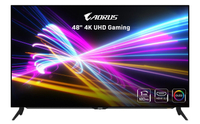Working from home has become the new normal for many people, so finding the best computer monitor is more important than ever. After all, you surely want to see the best visual quality from your coworkers' best webcams. And while many PC components are still enduring depressing shortages, performing a screen upgrade is one of the most accessible and impactful changes you can make to your gaming rig at the moment.
Below, we list the best computer monitors across various categories, from gaming to budget 4K and HDR.
But before diving into the deep end in a quest for the best computer monitor for you, we'll cover a few basics first.
What to Look for in a Best Gaming Monitor
Why you can trust Tom's Hardware Our expert reviewers spend hours testing and comparing products and services so you can choose the best for you. Find out more about how we test.
- What’s your monitor’s purpose? If it’s gaming, you’ll generally want something with a high refresh rate (ideally 100Hz or more), low response time and AMD FreeSync or Nvidia G-Sync for fighting screen tears at low framerates. For general use, look for high contrast, and for creative work prioritize color accuracy.
- What resolution do you want? More pixels means a sharper image. No one should be buying anything under 1080p/FHD (1920 x 1080) these days. But if your budget can handle it, 4K is as sharp as it gets at a reasonable price. Many gamers find 1440p/QHD (2560 x 1440) a good compromise between price and high-refresh-rate performance.
- Contrast and color. We consider contrast the most important factor in image quality, with 1,000:1 being solid. Color errors are particularly important avoid for content creators, and anything with a Delta E (dE) greater than 3 may show visible errors.
- Panel tech: When it comes to image quality, TN < IPS < VA. VA monitors typically still have better contrast than even the best IPS panels, although IPS panels are also known to be very colorful.
- What size do you want? These days, 24-inches is on the small side and 27 inches is mainstream, while 32-inches is a good large size for those on a budget. Anything bigger than 43 inches probably won’t fit on a regular desktop. For portable monitors, stay in the 17-inch range or under. Anything bigger isn't really all that portable.
- sRGB or DCI-P3? In most cases, you’ll either be getting a monitor made for the sRGB color space or the more colorful DCI-P3 one. Technically, Windows, the web and non-HDR games and video all use sRGB, but if you want an extra colorful screen, an accurate DCI-P3 monitor is more appropriate.
The Best Computer Monitors You Can Buy Today
Before we get into our primary list of picks, here is an amazing deal on one of our favorite tested monitors below. Sure, it's more of a TV than a monitor, but it's hard to pass up a big OLED screen for $600 (after an admittedly annoying $200 mail-in rebate).

Earning a 5-star rating from Tom's Hardware, the Samsung Odyssey G7 32-inch is the best computer monitor. For gamers, it boasts the strongest curve currently available, 1000R, for incredible immersion, along with speedy gaming numbers. The 240Hz monitor has a 1ms (GTG) response time and put up a 5ms response time score in our testing, beating some 165Hz screens by 2ms. In addition, benchmarking showed input lag at 20ms, a full 6 to 10ms faster than some 165Hz screens we’ve tested, including the Dell S3220DGF also on this page.
This is also a strong work monitor. Its 32-inch panel offers plenty of height for productivity, like working on long spreadsheets in a way that’s easier than on a 32-inch ultrawide. And at a 2 to 3-foot viewing distance, we don't have any distortion issues with that dramatic curve. Just be sure to bring your own audio because, despite the price, there are no speakers here.
No matter what you use the G7 for, you can expect strong image quality backed by 2,201:1 contrast out of the box, as well as accurate DCI-P3 color.
More: Samsung Odyssey G7 32-Inch review

The Dell S3222DGM is the best gaming monitor for many gamers. This follow-up to the highly-rated S3220DGF boasts a 32-inch VA panel, QHD resolution and 165 Hz refresh rate with Adaptive-Sync support. Other perks in its favor are 85 percent coverage of DCI-P3 and a display curve with an 1800mm radius.
However, Dell really knocks it out of the park with the S3222DGM's contrast ratio. VA panels are known for their excellent contrast, but the S3222DGM is rated at an impressive 3,000:1, easily blowing away IPS competitors. But our sample managed to better that figure by a third, coming in at 4,000:1 in instrumented tests.
This 32-inch monitor offers plenty of vertical screen real estate without the need for scrolling and 1440p resolution, the current sweet spot between image quality and gaming performance. And while the S3222DGM is targeted primarily at gamers, we found that it is also great for general productivity and anything in between.
While the S3222DGM lacks HDR support, its excellent contrast doesn't detract from that missing "bullet point" and its overall performance is hard to beat at this price point. Throw in Dell's usual solid build quality, and this represents a great monitor for enthusiasts looking to build out a mid to high-budget gaming PC.
More: Dell S3222DGM review

With a 1ms (GTG) response time and 144Hz refresh rate, the LG 27GN950-B is the best computer monitor for 4K gaming. If you’ve got the graphics card, ideally one of the best graphics cards, you need to handle 144 frames per second (fps) at 4K; this monitor will ensure that power doesn’t go to waste. In our testing, the monitor showed a 7ms response time, keeping up with pricier 4K, 144Hz screens, like the Asus ROG Swift PG27UQ, and even beating some when it came to input lag. Plus, FreeSync Premium Pro and G-Sync Compatibility will fight screen tears for those times when framerates drop below 48 fps.
Although VA panels are known for their high contrast, based on our benchmarks, this IPS monitor can hold its own, hitting 1,034.7 before calibration and 8,475.3:1 with HDR. Those who want the most accurate color may find the sRGB mode too saturated, but the 27GN950-B proved accurate when it came to the more colorful DCI-P3 space.
For more top-of-the-line 4K gaming screens, visit our Best 4K Gaming Monitors page.
More: LG 27GN950-B review

If you want an affordable screen with many pixels, the Samsung UR59C is the best budget 4K monitor for you. The VA panel delivers contrast (2590.5:1 after calibration), making everything from photos to videos to games look better. This is clearly not a high-end gaming monitor with a 60 Hz refresh rate, 4ms (GTG) response, and no FreeSync or G-Sync. But casual gamers can make do, thanks to the combination of high pixel density and high contrast, keeping games looking realistic.
Curves are generally more effective on ultrawide screens, but the UR59C’s 1500R curvature was effective and beneficial for this 32-incher, such as when multitasking with multiple windows. And if you don’t mind calibrating, you can get rid of the UR59C pesky color errors, which, unfortunately, were visible out of the box. Our calibration settings reduced the error from 4.3dE to 0.9dE.
Are you interested in more high-res, low-price displays? Check out our Best Budget 4K Monitors round-up.
More: Samsung UR59C review

Making HDR pop over SDR is all about contrast, and for the ultimate contrast, there’s nothing better than OLED. The Aorus FO48U’s massive OLED panel not only delivers immeasurably high contrast, but we recorded 107.7% coverage of the DCI-P3 color space and near-flawless grayscale tracking. As a result, you get a rich image that’s also accurate out of the box. However, it’s not as bright as a premium LCD (399 nits with HDR, according to our testing).
Aorus’ OLED monitor is fit for high-speed HDR gaming on both PCs and consoles, thanks to DisplayPort 1.4 with Display Stream Compression (DSC) and HDMI 2.1, respectively. The monitor held its own against 120Hz and 144Hz rivals in our speed tests, only falling 4ms behind its OLED gaming rival, the Alienware AW5520QF. Unfortunately, you don’t get Dolby Vision or support for the 50p and 24p TV formats, but the monitor has two 15W speakers and one 20w speaker for outstanding audio quality.
For more on ensuring your HDR upgrade is noticeable, read about how to choose the best HDR monitor.
More: Aorus FO48U review

Asus has gone all out with the ProArt PA32UCG, combining 1152 dimming zones in its full-array Mini-LED backlight. A quantum dot film covers a considerable color gamut, almost 78% of Rec.2020. And it is the brightest monitor we’ve ever tested at over 1700 nits peak. To that, it adds precise out-of-box accuracy for every color mode in use today. Though it includes many calibration options and a bundled colorimeter, it’s ready for work or play, with no tweaking necessary.
And unlike its predecessors in this league, the refresh rate isn't locked at 60 Hz. The ProArt PA32UCG brings FreeSync and G-Sync compatibility along with a 120 Hz refresh rate. If you need 144 Hz, you can do it over DisplayPort in the PA32UCG’s Rendering Mode. And its HDR support is complete as well. Many monitors deliver HDR10, but the ProArt is one of the very few to add Dolby Vision. Sure, the $5,000 price tag pushes this screen out of most people's price range, but if you're looking for the monitor that makes HDR content look its best while also being great for media creation and a little high-refresh gaming on the side, this monitor has no rival.
More: Asus ProArt PA32UCG review

A lot of us are finding ourselves working in tight spaces these days. If you’re looking to add another screen to your space, the Lenovo ThinkVision M14 is the best portable monitor. Its most standout feature is a critical one: a reliable, strong kickstand that’s easy to use, thanks to two flip-out feet. While many portable monitors are stuck with flimsy sleeves that double as stands, you can intuitively prop up the ThinkVision M14 at a -5 to 90-degree tilt or even in portrait mode. Unfortunately, its travel case isn’t as tough.
According to our benchmarks, with 244 nits max brightness and 98% coverage of the sRGB color space, the ThinkVision M14 is perfect for surfing the web or watching a movie in SDR. USB-C connectivity, meanwhile, means it won’t run out of battery when plugged into a laptop. It can also deliver as much as 65W of power to a device if plugged into a wall adapter. But those whose PC or device, such as a Raspberry Pi, doesn’t have a USB-C port with DisplayPort 1.2 Alt Mode and USB PD 2.0 or better will be out of luck.
If you prefer a portable touchscreen monitor, check out the touch version of the M14 via our Lenovo ThinkVision M14t review.
More: Lenovo ThinkVision M14 review

With a 240Hz refresh rate, 3ms (GTG) response time, and even FreeSync, the Asus ROG XG17AHPE stands high above the competition and easily snags the best portable gaming monitor crown.
However, the XG17AHPE is as expensive as it is unique. In fact, you can buy a much larger desktop-sized monitor with the same amount of speed for cheaper than this, over $400 17.3-incher. And the origami-style cover Asus includes isn’t sufficient for protecting this expensive piece of hardware or providing a reliable stand.
But the XG17AHPE also delivers strong side viewing angles, a lot of brightness (285.6 nits) and a surprising amount of color (109.5% sRGB). There are also many connectivity options, making it easy to tether it to everything from your laptop to your Raspberry Pi.
More: Asus ROG XG17AHPE review


